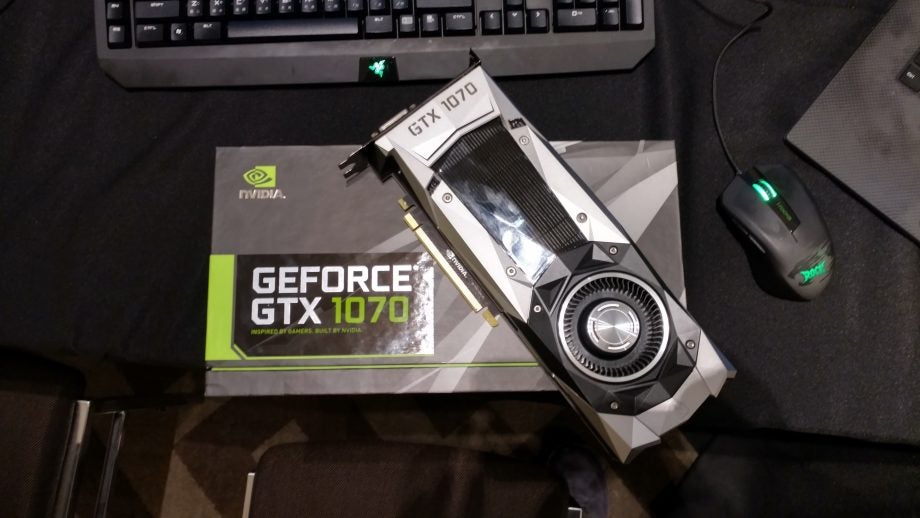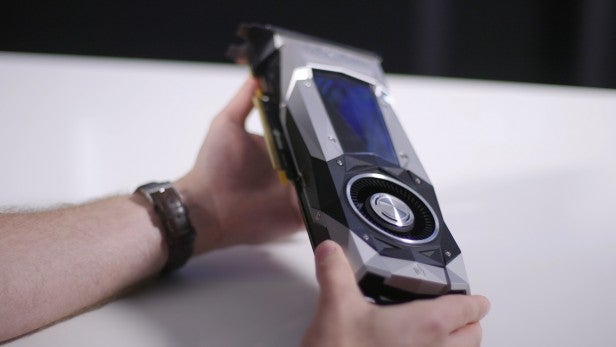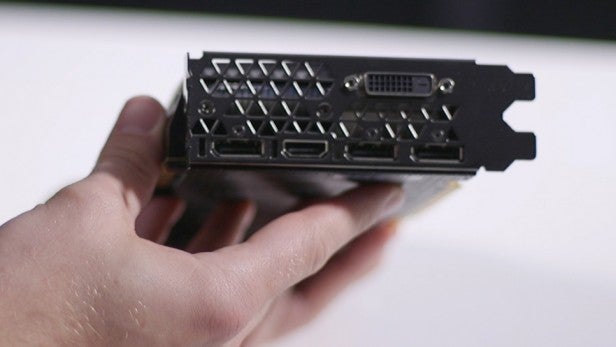Nvidia GeForce GTX 1070 Review
Nvidia GeForce GTX 1070 Review
The best value graphics card money can buy

Sections
- Page 1 Nvidia GeForce GTX 1070 Review
- Page 2 Performance, overclocking and conclusion Review
Verdict
Pros
- Excellent 1440p gaming performance
- Fantastically overclockable
- Very power efficient
- Super quiet while running
Cons
- Limited SLI capabilities
Key Specifications
- Review Price: £400.00
- 1920 CUDA cores
- Base clock speed: 1506MHz
- Boost clock speed: 1683MHz
- 8GB GDDR5 memory
Ray tracing was previously a unique selling point for Nvidia’s newer RTX cards, which are based on its latest Turing architecture. On the GTX line Ray Tracing support is limited to Direct X titles. We’ll be updating this review to see how the GTX 1070 handles Ray Tracing when the update rolls out. Check back then for our findings.
What is the Nvidia GeForce GTX 1070?
2016 has been a great year for PC gamers. We’ve seen the arrival of top-notch virtual-reality headsets, such as the HTC Vive and Oculus Rift, plus super-powered VR-focused graphics cards to back them up, such as the Nvidia GeForce GTX 1080.
With all the hype and optimism flooding the PC gaming market, you could be forgiven for overlooking the GTX 1080’s less powerful sibling that’s on test here. After all, if you’re going to upgrade your rig then the best option is the flagship, right?
But those who dismiss the 1070 will be making a serious mistake. Sharing a common “Pascal” DNA with the 1080, the 1070 is one of the best value-for-money offerings available and should be the first on the list for any PC owner looking to enjoy judder-free 1440p gaming.
Related: Best graphics card deals
Update: Since my original review of the GTX 1070, Nvidia has fleshed out its range of Pascal graphics cards, adding the new, VR-ready GTX 1060 to its roster. Not only is the GTX 1060 ready for whatever your Oculus Rift or HTC Vive throws at it, it also offers a much cheaper route into 1440p gaming. If you’re prepared to make some sacrifices in areas such as anti-aliasing and other fancy effects, it’ll reward you handsomely.
Take a look at our benchmark results on the second page of this review for more information on the differences between the two cards.
Nvidia GeForce GTX 1070 – Specs and technology explained
Nvidia didn’t shy away from making big claims about the 1080’s performance when it unveiled the card earlier this year. The company went so far as to claim it would outperform the £1,000-plus Titan X at certain tasks. Unsurprisingly, the 1070 took a back seat as Nvidia went all-out on 1080 marketing, but many onlookers expected the former to be Nvidia’s dark horse this year.
The 1070 has a lot to live up to; its predecessor, the 970 is running on one in 20 gaming PCs according to statistics from Valve’s Steam gaming service.
On paper, the card isn’t just a huge improvement on the 970, it can also hold its own against Nvidia’s £550 GTX 980 Ti.
The 1070’s use of Nvidia’s Pascal architecture plays a big part here. Pascal is the successor to Nvidia’s previous Maxwell GPU architecture. It improves on Maxwell using a smaller manufacturing process, which reduces the chip’s fabrication nodes from 28 nanometres to 16nm.
The Pascal architecture enables Nvidia to fit more transistors onto a smaller piece of silicon, thus increasing performance while reducing power consumption to a modest 150W.
Thanks to Pascal, Nvidia has been able to cram 1,920 CUDA cores onto the 1070 – the foot soldiers of a GPU that do the majority of the computational-heavy lifting. This is a marked improvement over Nvidia’s GTX 970 card, which houses 1,664 CUDA cores, but still firmly behind the 1080’s 2,560.
Pascal also brings to the mix Nvidia’s answer to asynchronous computing. Async compute technology, used by AMD, enables a GPU to work on graphics and computing tasks simultaneously, therefore allowing a card to complete jobs faster. Nvidia’s version of the tech is called “pre-emption”, and works slightly differently: it allows the GPU to more intelligently choose which processes to prioritise.
The technology isn’t a big deal right now, since most games still use APIs that don’t support async computing or pre-emption. But with both Vulkan and DirectX 12 growing in use, it will become important in the very near future.
Buy Now: Nvidia GeForce GTX 1070 at Amazon.co.uk (£380) | Amazon.com ($449.99)
Nvidia’s boosted the 1070’s speed to 1,506MHz, which again is a significant improvement on the 970’s 1,050MHz core clock speed; the 1080 clocks in at a slightly higher 1,607MHz.
Watch: Your graphics card questions answered – #AskTrusted
The only possible quibbles you could have with the 1070’s core specs is that it doesn’t feature the GDDR5X memory seen on the GTX 1080 and is limited to a two-card SLI configuration.
GDDR5X memory is a new generation of RAM that’s much faster, but it’s also more expensive than GDDR5. The tech means the 1080’s 8GB of GDDR5X memory had a clock speed of 10,000MHz.
To me the lack of GDDR5X memory shouldn’t be an issue, and when you consider the 1070’s competitive £399 price, you can’t be too disappointed. The card’s 8GB of GDDR5 memory, which features a 256-bit bus for 256GB/sec of memory bandwidth, will meet most regular gamers’ needs.
It’s also a marked improvement on the 970, whose lack of memory proved a constant problem. The 970 features a more modest 4GB of GDDR5 memory, only 3.5GB of which was generally usable for the majority of the time. This made 4K gaming on it a pipe dream and 1440p a serious push.
Related: Best Graphics Card 2016
Nvidia is only officially supporting two-way SLI with the GTX 1070. You can get an unlock code to add more cards, but if you do, the three-to-four SLI setup will only work on selected benchmarking applications, such as 3DMark. 
Hardcore spec-heads have been up in arms about this, but I believe the complaint is unwarranted. Back in the day, there may have been a reason to connect multiple GPUs, but these days there’s little need for home users. The GTX 1070 and 1080 are both powerhouses, and the fact remains that running multiple GPUs comes with all manner of complications – chief of which is the fact that VR headsets and some game engines don’t like it.
In my mind, it’s the VR part of the argument that allows me to forgive the lack of SLI options. This is especially true when you account for the amount of work Nvidia has done with regards to optimising the 1070 for VR. The 1070 has the same Lens Matched Shading, Simultaneous Multi-Projection tech as the 1080.
You can read more about Pascal’s new technology in our Nvidia GeForce GTX 1080 review.


